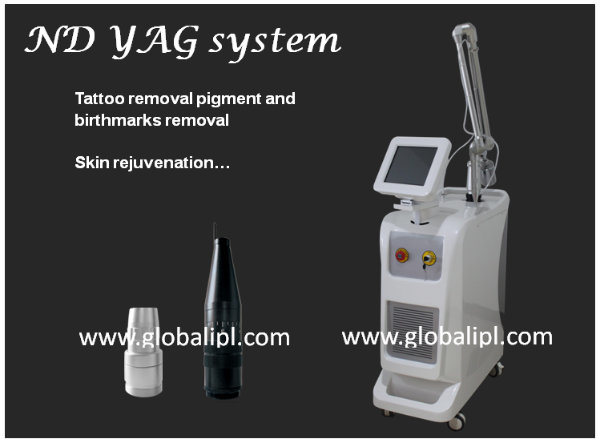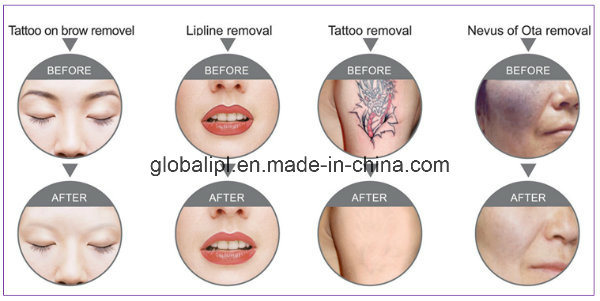
Applications:
1. Pigment deposit dispelling
2. Skin Rejuvenation
3. Tattoo removal: Remove black, blue, brown, and colorful (such as red, yellow, green) tattoo on eyebrow, eye line, lip line, and other parts of bodyÂ
4. Eliminates the age pigments, spots, birthmarks, and pigment changes

Features:
1.Electro-optic Q-switch ND yag laser, releases actual single pulse of laser energy. Really achieve to painless treatment and micro-injury to skin, long-term lasting treatment result.
2. Single pulse energy 800mj
3. Professional for skin rejuvenation
4. Spot size: 1~7 mm adjustable
5. Alarm protection system of water flow and water temperature: protect people and machine against any risk at the first time.
Advantages:
1.The screen can be folded up and down,rotate 180°left and right

2. It adopt international new smart 6 segments segments articular arm, the exclusive manufacturer of using this technology in China.
3. High quality of pure green light, offers perfect performance.
4. Main elements such as Q Switch and polarizer are imported from international famous company, and advanced technology of laser cavity is used to produce excellent light spot modes, even light intensity, no highlighted point.
5. Imported light route from South Korea, ensure energy stabilization.
6. Imported water pump, no noise and larger water flow for better cooling, prolong laser life.
Working Theory:
Laser tattoo equipment adopts the Q switch mode, which makes use of the instantaneous emitted laser to break the pigment in ill structure. That's the laser instantaneous emit theory: Centralized high energy emit suddenly, which makes laser of settled wave band instantaneously penetrate through cuticle to the ill structure in 6ns, and break the relevant pigments quickly. After absorb the heat, the pigments swell and break down, some pigments ( in skin-deep cuticle ) fly off the body immediately, and other pigments ( deep structure ) break down then become the tiny granule can be licked up by the cell, digested and egest from the lymph cell. Then the pigments in ill structure lighten to disappear. Moreover, the laser do not damage the around normal skin.Â
Specification
Laser type: |
Nd. Yag Laser (q-switch) |
Wavelength: |
1064nm/532 nm |
Diameter of spot: |
1-7 mm, with adjustable treatment probes |
Laser aiming: |
red semiconductor aiming light, wavelength is 650nm-670nm |
width of pulse: |
6~12ns |
Single pulse energy: |
800mj |
Frequency: |
1~10 Hz |
Cooling system: |
closed-off water circulation inside + air cooling |
Machine zise: |
83*32*83cm |
Net weight: |
60kgs |
Voltage: |
220V/110V |
Polysaccharides are polymeric carbohydrate molecules composed of long chains of monosaccharide units bound together by glycosidic linkages, and on hydrolysis give the constituent monosaccharides or oligosaccharides. They range in structure from linear to highly branched. Examples include storage polysaccharides such as starch and glycogen, and structural polysaccharides such as cellulose and chitin.
Polysaccharides are often quite heterogeneous, containing slight modifications of the repeating unit. Depending on the structure, these macromolecules can have distinct properties from their monosaccharide building blocks. They may be amorphous or even insoluble in water. When all the monosaccharides in a polysaccharide are the same type, the polysaccharide is called a homopolysaccharide or homoglycan, but when more than one type of monosaccharide is present they are called heteropolysaccharides or heteroglycans.
Natural saccharides are generally of simple carbohydrates called monosaccharides with general formula (CH2O)n where n is three or more. Examples of monosaccharides are glucose, fructose, and glyceraldehyde. Polysaccharides, meanwhile, have a general formula of Cx(H2O)y where x is usually a large number between 200 and 2500. When the repeating units in the polymer backbone are six-carbon monosaccharides, as is often the case, the general formula simplifies to (C6H10O5)n, where typically 40≤n≤3000.
As a rule of thumb, polysaccharides contain more than ten monosaccharide units, whereas oligosaccharides contain three to ten monosaccharide units; but the precise cutoff varies somewhat according to convention. Polysaccharides are an important class of biological polymers. Their function in living organisms is usually either structure- or storage-related. Starch (a polymer of glucose) is used as a storage polysaccharide in plants, being found in the form of both amylose and the branched amylopectin. In animals, the structurally similar glucose polymer is the more densely branched glycogen, sometimes called "animal starch". Glycogen's properties allow it to be metabolized more quickly, which suits the active lives of moving animals.
Cellulose and chitin are examples of structural polysaccharides. Cellulose is used in the cell walls of plants and other organisms, and is said to be the most abundant organic molecule on Earth.It has many uses such as a significant role in the paper and textile industries, and is used as a feedstock for the production of rayon (via the viscose process), cellulose acetate, celluloid, and nitrocellulose. Chitin has a similar structure, but has nitrogen-containing side branches, increasing its strength. It is found in arthropod exoskeletons and in the cell walls of some fungi. It also has multiple uses, including surgical threads. Polysaccharides also include callose or laminarin, chrysolaminarin, xylan, arabinoxylan, mannan, fucoidan and galactomannan.
Polysaccharide Series,Cordyceps Polysaccharide,Hericium Erinaceus Polysaccharide,Goji Polysaccharide
Excellent Health Products Co.,Ltd , http://www.sino-excellent.com